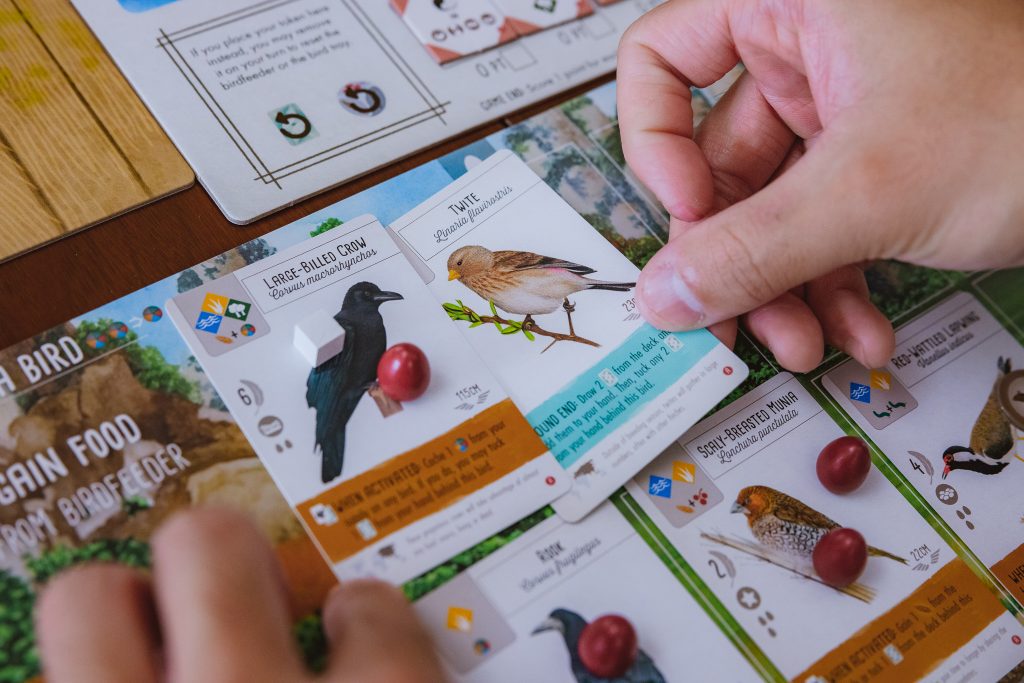
No AI art: Wingspan, Scythe maker Stonemaier Games draws hard line on using AI in ‘creative work’
Wingspan and Scythe publisher Stonemaier Games has come out strongly against using AI in creative work, with co-founder Jamey Stegmaier telling BoardGameWire his company wants “nothing to do with it”.
Stegmaier’s announcement that his company “does not, has not, and will not use any form of AI to replace or augment creative work” follows several high-profile instances of AI being used to generate artwork in the board game industry – all accompanied by a sizeable backlash from industry professionals and tabletop gamers.
Just a few weeks ago Awaken Realms took down AI-generated promotional images for its newly-announced Puerto Rico 1897 Special Edition crowdfunding campaign after being contacted by the game’s licensor Ravensburger.
Last September board game publishers, artists and players took to social media and BoardGameGeek forums to condemn FryxGames and Stronghold Games using AI art in the development of the latest Terraforming Mars Kickstarter campaign, which raised more than $2.2m from over 19,000 backers.
Essen Spiel, the world’s biggest board game fair, came under fire a month later after admitted using controversial AI-generated art on its tickets, posters and app for its 2023 event.
Much of the ire directed at AI art users in the industry has stemmed from the way generative AI creates its images, with the most successful software relying on being fed huge quantities of publicly-available artwork – usually without the consent of the artists, or with any attempt to compensate them for building technology using their creations.
Stegmaier told BoardGameWire, “I want to play games designed by, illustrated by, and written by people, not algorithms.
“Same with books, movies, TV shows, songs, etc – I understand that technology plays a role in anything we create, but as a person and a publisher, I’m interested in humans as the source of that content.
“As for the timing of the statement, Stonemaier’s stance is something I wrote on my ‘to-write-about’ list almost a year ago. I wasn’t sure what else to say about it, though, or how my personal and professional opinion might add value to other creators.
“But over the last few months it seems that more and more of the apps I use on a daily basis are offering their AI to create content for me – it’s in my face every day in various ways. So I was compelled to survey Stonemaier Ambassadors, and with that data in hand, I thought I finally had something to write about.”
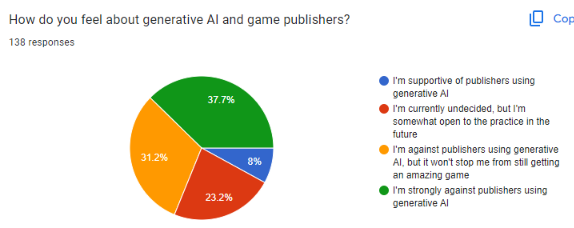
Stonemaier’s survey of its Ambassadors – volunteers who help teach its games at conventions, translate rulebooks and answer questions about its games on internet forums – revealed that almost 70% of respondents were against publishers using generative AI, although almost half of those said its use wouldn’t stop them from buying “an amazing game”.
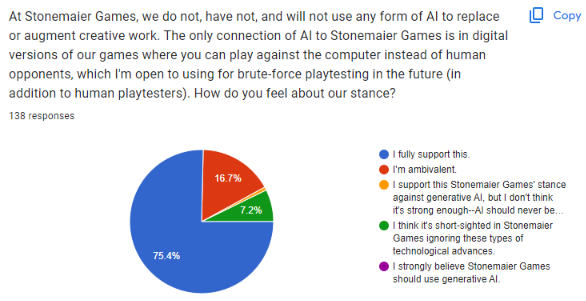
Just 7.2% of respondents believed the company was being short-sighted in ignoring technological advances like generative AI, with more than 75% supportive of its stance and another 16.7 % ambivalent to its decision.
Stegmaier told BoardGameWire, “You know, the first time I ever felt there was any pressure to explore AI at Stonemaier Games was in reading the responses to the article.
“There were a few people who said things like, ‘You’re doomed as a publisher if you don’t use AI’ or ‘You say this now, but we’ll see how you feel in a few years.’
“This is still surprising to me – are there actually tabletop gamers who actively want publishers to use AI to create art, write text, and design games? At least in our limited survey of Stonemaier Ambassadors, not a single person replied ‘I strongly believe Stonemaier Games should use generative AI’.”
Stegmaier did add that he believes there are ‘grey areas’ around generative AI art use, saying that, for example, “if a designer submits a game to us with a few temporary illustrations generated by AI, I’m fine with that”.
He added, “I’m fine that digital versions of our games allow players to compete against AI opponents. And I’m open to brute-force AI playtesting to add to our human playtesting process. But using AI to create art, write text, or design games? I’m truly not interested at all in that for Stonemaier Games.”
Stegmaier said his anecdotal take from speaking with a few other board game publishers was that some want nothing to do with it, and some seem fine with using temporary placeholder art for internally-created prototypes – but added that he couldn’t recall speaking with a publisher directly who wanted to use AI art in their games.
When asked if the polarising nature of AI art in board gaming might lead to a ‘two tier’ system, with some publishers leaning into AI-created work and others actively against it, he said, “Perhaps. I think the tipping point for this being more than just an outlier is if there is a breakthrough-level game – a game that appears in the BoardGameGeek top 10 rankings – that uses and is transparent about its heavy use of AI from the start.

“I don’t know if that will happen, nor am I hoping it happens, but I think that will be the true sign that a major shift has happened in the gaming industry.”
For playtesting, he cited a potential future where “you can feed a near-final prototype into an AI playtest bot and have it spit out 10,000 games’ worth of data in a few minutes”.
He said, “I don’t see this as replacing human playtesters at all, but it could be helpful for identifying circumstantial, niche, and asymmetric imbalances.
“That’s an example of AI doing something that humans can’t replicated, at least not within any reasonable timeframe. If that were ever possible, I would only see it in addition to our current playtesting process, which begins locally and then expands to three to six waves of blind playtesting… [before bringing in] a data analyst to look at that playtest data to see if we’re missing anything.
“…This entire playtesting and development process typically takes around six months, but it can be longer depending on the game.
“Using AI would extend this process, not replace it: If I could run the final, fully playtested prototype through 10,000 AI playtests, it would almost certainly find a least a few imbalances to fix, and I would need to playtest the game with those fixes afterwards.”
When asked what advice he could give to first-time designers and publishers tempted to use AI art because of its affordability, he said, “My stance on generative AI for Stonemaier Games comes from a place of privilege.
“We can afford to pay for hundreds of unique illustrations created by amazing human artists, but it wasn’t that long ago that I had only around $1,000 to spend on Viticulture’s art (2012).
“I found some artists who worked quickly and at a price I could afford. The size of the illustration, the level of coloring, the number of duplicated features, and whether or not the backgrounds are unique all play into the cost of the art – you can adjust those levers to find something that is visually appealing but also budget friendly.
“And what’s fair to the artist greatly depends on where the artist is in their career. Instead of approaching a famous Magic: The Gathering artist, find someone new who is looking to make a name for themselves.
“Pay them fairly, of course – exposure is not payment – but you’ll likely find their costs significantly lower than a well-established artist.”



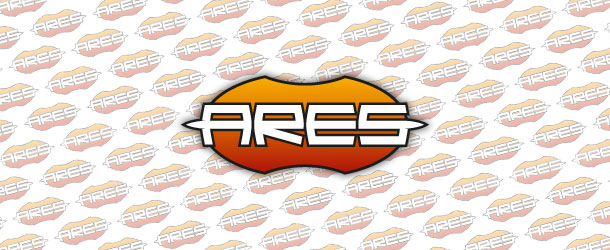
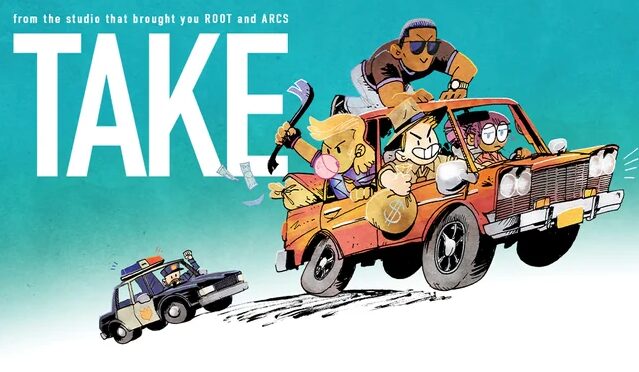
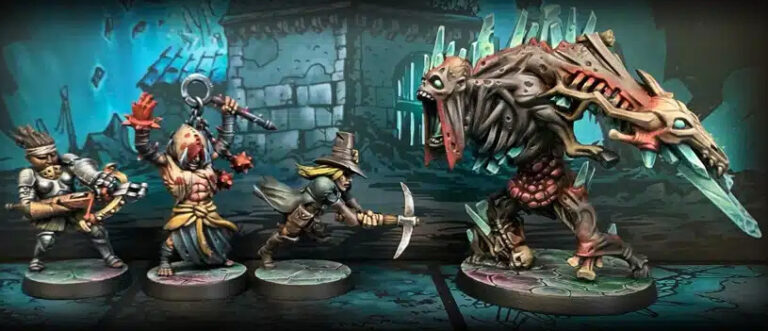
[…] (April 24, 2024): Board Game Wire has an article on this topic in which I answered some […]
[…] […]
[…] and Scythe publisher Stonemaier Games came out strongly against using AI in creative work, with co-founder Jamey Stegmaier telling BoardGameWire last month that his company wants “nothing to do with […]
[…] The highest profile of those so far has been Wingspan and Scythe publisher Stonemaier Games, with co-founder Jamey Stegmaier telling BoardGameWire in April that his company wants “nothing to do with it”. […]